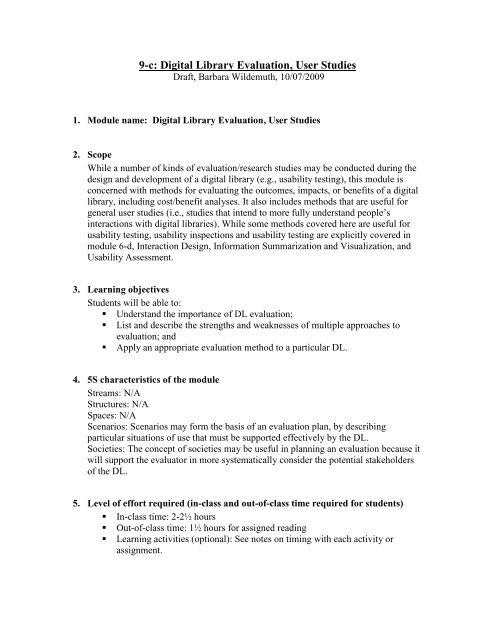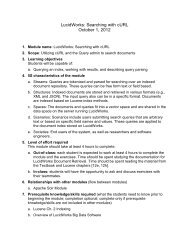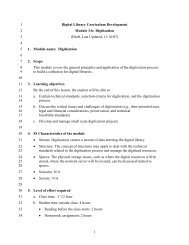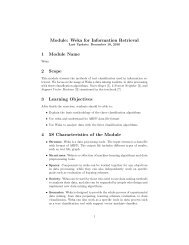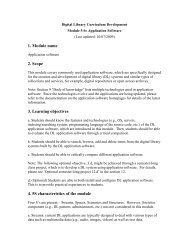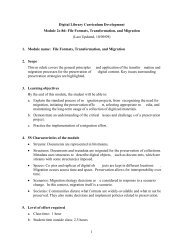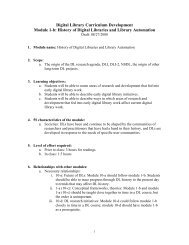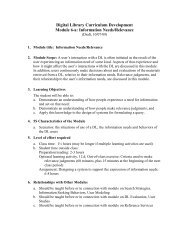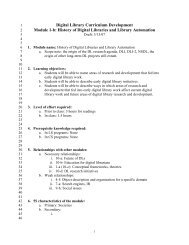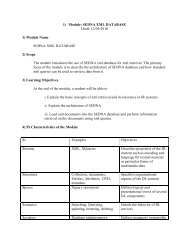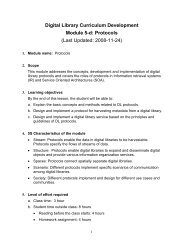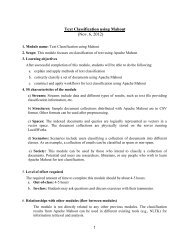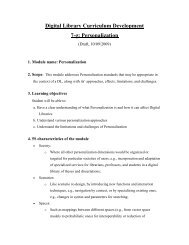9-c - Digital Library Curriculum Project
9-c - Digital Library Curriculum Project
9-c - Digital Library Curriculum Project
Create successful ePaper yourself
Turn your PDF publications into a flip-book with our unique Google optimized e-Paper software.
9-c: <strong>Digital</strong> <strong>Library</strong> Evaluation, User Studies<br />
Draft, Barbara Wildemuth, 10/07/2009<br />
1. Module name: <strong>Digital</strong> <strong>Library</strong> Evaluation, User Studies<br />
2. Scope<br />
While a number of kinds of evaluation/research studies may be conducted during the<br />
design and development of a digital library (e.g., usability testing), this module is<br />
concerned with methods for evaluating the outcomes, impacts, or benefits of a digital<br />
library, including cost/benefit analyses. It also includes methods that are useful for<br />
general user studies (i.e., studies that intend to more fully understand people’s<br />
interactions with digital libraries). While some methods covered here are useful for<br />
usability testing, usability inspections and usability testing are explicitly covered in<br />
module 6-d, Interaction Design, Information Summarization and Visualization, and<br />
Usability Assessment.<br />
3. Learning objectives<br />
Students will be able to:<br />
• Understand the importance of DL evaluation;<br />
• List and describe the strengths and weaknesses of multiple approaches to<br />
evaluation; and<br />
• Apply an appropriate evaluation method to a particular DL.<br />
4. 5S characteristics of the module<br />
Streams: N/A<br />
Structures: N/A<br />
Spaces: N/A<br />
Scenarios: Scenarios may form the basis of an evaluation plan, by describing<br />
particular situations of use that must be supported effectively by the DL.<br />
Societies: The concept of societies may be useful in planning an evaluation because it<br />
will support the evaluator in more systematically consider the potential stakeholders<br />
of the DL.<br />
5. Level of effort required (in-class and out-of-class time required for students)<br />
• In-class time: 2-2½ hours<br />
• Out-of-class time: 1½ hours for assigned reading<br />
• Learning activities (optional): See notes on timing with each activity or<br />
assignment.
9-c, DL Evaluation/User Studies<br />
Page 2<br />
6. Relationships with other modules (flow between modules)<br />
It is expected that this module will follow other modules on digital libraries, and will<br />
be in the final portions of the module sequence.<br />
7. Prerequisite knowledge required (completion optional)<br />
Students will not be expected to have had prior training in social science research<br />
methods.<br />
8. Introductory remedial instruction: None<br />
9. Body of knowledge<br />
Evaluation and user studies:<br />
Definition of evaluation: “An appraisal of the performance or functioning of a<br />
system, or part thereof, in relation to some objective(s)” Saracevic, 2000,<br />
p.359<br />
Evaluation incorporates the making of value judgments about whether<br />
performance is adequate<br />
Its purpose is to inform decision making (Reeves et al., 2003)<br />
Evaluation is critical to any project<br />
NSF recommended that at least 10% of the project budget be devoted to<br />
evaluation in their early DL initatives<br />
User studies may be more general, in terms of the types of questions asked<br />
They do not necessarily incorporate the making of value judgments about<br />
performance quality<br />
User studies may be more specific, in that they involve users<br />
Evaluations may be conducted on the DL collection or other aspects of the<br />
DL without involving users<br />
This module will focus particularly on evaluations that involve users<br />
The object of the evaluation or user study: digital libraries and their<br />
processes/functions<br />
A particular aspect of a digital library<br />
Individual digital libraries<br />
Multiple digital libraries
9-c, DL Evaluation/User Studies<br />
Page 3<br />
DL processes that may be evaluated (based on Saracevic, 2005), and criteria for<br />
evaluation<br />
Information representations, metadata and surrogates used in the DL<br />
Task appropriateness<br />
Usability<br />
User satisfaction<br />
Particular tools available in the DL<br />
Index, search, and output features<br />
Navigation, browsing<br />
Failures in functionality or usability<br />
User satisfaction<br />
Particular services offered by the DL<br />
Collection quality<br />
Retrieval performance (recall, precision)<br />
Reliability<br />
Human-intermediated services (e.g., reference services)<br />
User satisfaction with individual services or with collection of<br />
services<br />
User behaviors when interacting with the DL (may or may not be<br />
evaluative)<br />
Information seeking/searching behaviors<br />
Use of information retrieved<br />
Work patterns<br />
“All efforts to design, implement, and evaluate digital libraries must be rooted in the<br />
information needs, characteristics, and contexts of the people who will or may use<br />
those libraries.” Marchionini, Plaisant, & Komlodi, 2003, p.1<br />
Questions that may be asked during an evaluation/user study<br />
Frame the study questions based on the decisions that must be made about the<br />
DL’s functions/processes (Reeves et al., 2003)<br />
Focus on those questions that are most important for making the decisions<br />
that are most important<br />
Focus on impacts of DL functions/services (Marchionini, Plaisant, &<br />
Komlodi, 2003)<br />
What types of impacts are there? On whom?<br />
Who and what influence those impacts?<br />
Formative versus summative evaluation<br />
Formative evaluation focused on decisions about how to modify/change<br />
the DL’s functions/services<br />
Summative evaluation focused decisions about the worth or value of the<br />
DL’s functions/services
9-c, DL Evaluation/User Studies<br />
Page 4<br />
Stages/steps in the evaluation/research process<br />
Develop an evaluation/research plan (Chowdhury & Chowdhury, 2003; Reeves et<br />
al., 2003)<br />
Clarify the decisions to be addressed and the questions they generate<br />
Identify appropriate evaluation methods, including sampling procedures,<br />
data collection procedures and data analysis procedures<br />
Carry out the evaluation/research plan<br />
Report the results to appropriate stakeholders<br />
Primarily the decision makers<br />
Also other constituencies of the DL<br />
Review of an example evaluation, in terms of these steps<br />
Possible example evaluations:<br />
Bishop, A.P. (1998, December). Measuring access, use, and success in<br />
digital libraries. The Journal of Electronic Publishing, 4(2). Retrieved<br />
February 8, 2006, from www.press.umich.edu/jep/04-02/bishop.html.<br />
Marchionini, G. (2000). Evaluating digital libraries: A longitudinal and<br />
multifaceted view. <strong>Library</strong> Trends, 49(2), 304-333.<br />
Evaluation design strategies<br />
Naturalistic studies<br />
For some evaluation studies, it is critical to conduct them in a natural or<br />
naturalistic setting/context<br />
The constraints of the setting usually imply that fewer experimental<br />
controls can be applied to the study design<br />
Usually, the evaluator will need to take into account aspects of the setting<br />
as part of the data collected for the evaluation study<br />
Experiments<br />
Usually conducted in a lab setting, or a setting in which control over the<br />
conditions of the evaluation study can be exerted<br />
The researcher attempts to control all the potential effects on the results of<br />
the study, other than those effects being intentionally manipulated as<br />
the focus of the evaluation<br />
Some important concepts in designing an experiment<br />
Randomization is a key tool for control: random sampling and/or<br />
random assignment to treatment and control groups<br />
Variables: the researcher will manipulate the independent variables<br />
(e.g., whether the DL has a particular feature or not) and will<br />
evaluate the outcomes based on the dependent variable
9-c, DL Evaluation/User Studies<br />
Page 5<br />
The design may be a within-subjects design (where each<br />
participant interacts with all the variations of the independent<br />
variables, and so comparisons on the dependent variable are<br />
made “within” each subject’s performance) or a betweensubjects<br />
design (where each participant interacts with only one<br />
version of the system and comparisons are made “between”<br />
groups of subjects)<br />
Avoiding the effects of researcher bias<br />
It’s easy for a researcher’s biases to influence the design of a study and,<br />
thus, its outcomes<br />
Identify your biases<br />
Ensure that your study design and procedures will allow you to<br />
avoid any influence on the study outcomes<br />
Data collection and measurement methods<br />
Collecting data from people requires ethical treatment of those people as study<br />
participants<br />
Each institution will require review of the research proposal by an<br />
Institutional Review Board that verifies that study participants are<br />
being treated ethically<br />
Observation of user behaviors, including transaction logs<br />
To see what the user is doing as he or she interacts with the system<br />
Observation of work (e.g., via contextual inquiry)<br />
Special kind of interview<br />
Observe person while performing task to be supported<br />
Interrupt with questions about how and why, as needed<br />
Think-aloud protocols<br />
During DL use, the participant is asked to verbalize their thought<br />
processes<br />
Allows you to observe “unobservable” cognitive behaviors<br />
Usually videotaped or audiotaped<br />
Indirect observation of work<br />
Logging and metering techniques embedded in the software of the<br />
current system or intermediate versions
Diaries<br />
For detailed descriptions of tasks<br />
How much time they take<br />
Sequential dependencies between tasks<br />
Interviews and focus groups<br />
Questionnaires<br />
9-c, DL Evaluation/User Studies<br />
Page 6<br />
Allows observation over longer periods of time than contextual<br />
inquiry interviews<br />
Augmenting other data collection methods, or on their own<br />
Uses during DL evaluation<br />
For identifying problems in the DL design<br />
For additional features needed in the DL<br />
For other improvements in the DL which the user can suggest<br />
Individual interviews or group interview (focus groups)<br />
Focus groups require a skilled facilitator<br />
Surveys: typically one item/question per construct<br />
Measures: intended to measure constructs that are not directly observable<br />
and not easily measured with a single item<br />
The more subjective the construct, the more likely that you will<br />
need a multiple-item measure for it<br />
Find a measure in the literature, rather than developing<br />
your own<br />
Print vs. online administration<br />
Print allows people to annotate (can be good or bad)<br />
Online eliminates the need for a separate data entry step<br />
Study sample: Who should be participants in your evaluation study?<br />
Define the population of interest<br />
Current users or a subset of them<br />
Potential audiences (who are not current users)<br />
Consider sample size<br />
Usually a tradeoff between small sample (cheaper) and generalizability<br />
Intensive versus extensive studies
Develop a sampling plan<br />
9-c, DL Evaluation/User Studies<br />
Page 7<br />
Intensive studies: to thoroughly understand a phenomenon within<br />
its context<br />
Extensive studies: to understand the extent of a phenomenon<br />
within a population<br />
Random sampling<br />
Supports statistical inferences to the population<br />
Identify a population to which you want to generalize your<br />
findings<br />
Enumerate the population<br />
Draw a random sample<br />
Problem: enumerating the entire population<br />
Not necessarily problematic, but often is<br />
Other methods of sampling<br />
Quota sampling, purposive sampling, accidental/convenience<br />
sampling<br />
Strive for representativeness<br />
In range, as well as central tendency<br />
Develop a plan for recruiting the sample you want<br />
May need to offer incentives<br />
Analysis and interpretation of data<br />
Reporting the results and interpreting the results are two distinct steps<br />
Interpretation should address the questions, “What do the results mean? How<br />
should they be understood?”<br />
All results must be interpreted in the context of:<br />
Prior empirical work and relevant theoretical frameworks<br />
Situation<br />
What is happening in the particular situation in which the study<br />
was done?
9-c, DL Evaluation/User Studies<br />
Page 8<br />
Weaknesses in the research<br />
Measurements: level of reliability; validity<br />
Design: attrition, external events; internal and external threats to<br />
validity<br />
Analysis method: assumptions violated<br />
Recommend particular actions, based on the interpretation of the results<br />
10. Resources<br />
Assigned readings for students:<br />
Nicholson, Scott. (2004). A conceptual framework for the holistic measurement and<br />
cumulative evaluation of library services. Journal of Documentation, 60(2), 164-<br />
182.<br />
Reeves, Thomas, Apedoe, Xornam, & Hee Woo, Young. (2003). Evaluating digital<br />
libraries: A user-friendly guide. University Corporation for Atmospheric<br />
Research; National Science <strong>Digital</strong> <strong>Library</strong>. Retrieved 3/1/2007 from<br />
http://quod.lib.umich.edu/cgi/t/text/textidx?c=jep;view=text;rgn=main;idno=3336451.0004.207.<br />
Chapter 1, Why evaluate? (p.1-6)<br />
Chapter 2, Evaluating planning (p.7-21)<br />
Recommended background reading for instructor:<br />
Chowdhury, G.G., & Chowdhury, S. (2003). <strong>Digital</strong> library evaluation. In<br />
Introduction to <strong>Digital</strong> Libraries. London: Facet Publishing, 267-283.<br />
Frechtling, J. (2002). The 2002 User Friendly Handbook for <strong>Project</strong> Evaluation.<br />
National Science Foundation, Directorate for Education & Human Resources,<br />
Division of Research, Evaluation, and Communication.<br />
Marchionini, G., Plaisant, C., & Komlodi, A. (2003). The people in digital libraries:<br />
Multifaceted approaches to assessing needs and impact. In Bishop, A.P., Van<br />
House, N.A., & Buttenfield, B.P. (eds.), <strong>Digital</strong> <strong>Library</strong> Use: Social Practice in<br />
Design and Evaluation. Cambridge, MA: MIT Press, 119-160.<br />
Reeves, Thomas, Apedoe, Xornam, & Hee Woo, Young. (2003). Evaluating digital<br />
libraries: A user-friendly guide. University Corporation for Atmospheric<br />
Research; National Science <strong>Digital</strong> <strong>Library</strong>. Retrieved 3/1/2007 from<br />
http://www.dpc.ucar.edu/projects/evalbook/Evaluating<strong>Digital</strong>Libraries.pdf.<br />
Saracevic, T. (2000). <strong>Digital</strong> library evaluation: Toward evolution of concepts.<br />
<strong>Library</strong> Trends, 49(2), 350-369.
9-c, DL Evaluation/User Studies<br />
Page 9<br />
Additional potential readings include:<br />
Bishop, A.P. (1998, December). Measuring access, use, and success in digital<br />
libraries. The Journal of Electronic Publishing, 4(2). Retrieved 2/8/2006 from<br />
www.press.umich.edu/jep/04-02/bishop.html.<br />
Bishop, A.P., Mehra, B., Bazzell, I., & Smith, C. (2003). Participatory action research<br />
and digital libraries: Reframing evaluation. In Bishop, A.P., Van House, N.A., &<br />
Buttenfield, B.P. (eds.), <strong>Digital</strong> <strong>Library</strong> Use: Social Practice in Design and<br />
Evaluation. Cambridge, MA: MIT Press, 161-189.<br />
Bollen, J. and R. Luce. (2002). Evaluation of digital library impact and user<br />
communities by analysis of usage patterns. D-Lib Magazine, 8(6) June 2002.<br />
Retrieved 3/1/2007 from http://www.dlib.org/dlib/june02/bollen/06bollen.html<br />
Bryan-Kinns, Nick & Blandford, Ann. (2000). A survey of user studies for digital<br />
libraries. RIDL Working Paper. Retrieved 3/1/2007 from<br />
http://www.cs.mdx.ac.uk/ridl/DLuser.pdf.<br />
Choudhury, G.S.; Hobbs, B.; M Lorie, Flores, N.E. (2002, July/August). A<br />
framework for evaluating digital library service. D-Lib Magazine, 8(7/8).<br />
Retrieved 3/1/2007 from<br />
http://www.dlib.org/dlib/july02/choudhury/07choudhury.html.<br />
Marchionini, G. (2000). Evaluating digital libraries: A longitudinal and multifaceted<br />
view. <strong>Library</strong> Trends, 49(2), 304-333.<br />
Rieger, R., & Gay, G. (1999, June 15). Tools and Techniques in Evaluating <strong>Digital</strong><br />
Imaging <strong>Project</strong>s. RLG DigiNews.<br />
Saracevic, Tefko (2005). How were digital libraries evaluated? Presented at Libraries<br />
in the <strong>Digital</strong> Age (LIDA), Dubrovnik and Mljet, Crotia, May 30-June 3.<br />
Retrieved 3/1/2007 from<br />
http://www.scils.rutgers.edu/~tefko/DL_evaluation_LIDA.pdf.<br />
Thong, J. (2002). Understanding user acceptance of digital libraries: What are the<br />
roles of interface characteristics, organizational context, and individual<br />
differences? International Journal of Human-Computer Studies, 57(3), 215-242.<br />
11. Concept Map (created by students)<br />
12. Exercises / Learning activities<br />
a. Analyze a DL evaluation report<br />
Exercise 13.a, “Analyze a DL evaluation report,” could be adapted to an in-class<br />
small-group discussion exercise. If so, the results of the each group’s analysis could<br />
be reported orally or could be posted to a class wiki or discussion forum.<br />
If used as an in-class exercise, assign the groups to read a particular evaluation report<br />
before class, to prepare for their in-class discussion and report.
9-c, DL Evaluation/User Studies<br />
Page 10<br />
Time requirements: 2 hours of preparation outside of class; 25-30 minutes for<br />
discussion in class; 20-30 minutes for report presentation in class, depending on the<br />
number of groups.<br />
b. Develop an evaluation plan<br />
Based on a DL that is familiar to all the students in the class (e.g., flickr, MySpace, a<br />
music collection, the university’s OPAC or a special collection that is well-known),<br />
have students work in small teams (3-4 people each) to develop a draft evaluation<br />
plan. They can play the role of an evaluation consulting firm, designing an evaluation<br />
study for their client, the DL managers.<br />
Each plan should include the following:<br />
The evaluation questions to be addressed<br />
Stated briefly, in one sentence (preferably ending with ?)<br />
The sample to be included<br />
How they will be selected<br />
How they will be recruited<br />
The methods for data collection<br />
The types of data to be collected, and how each pertains to the evaluation<br />
question<br />
The procedures for collecting the needed data<br />
Have each team of students present their plan to the class, as if it were an initial<br />
presentation to the client (the DL managers).<br />
Time requirements: It is expected that the students will prepare their report after this<br />
module has been presented in class. Students should expect to spend 4-5 hours<br />
outside of class, preparing their reports. Each report should be presented in 7-10<br />
minutes, during the next class session.<br />
c. Interview a digital librarian about evaluation<br />
Note: This exercise is only possible if there are a number of robust local digital<br />
library projects, and the students will have access to their directors/administrators.<br />
For this exercise, students should work in pairs; each pair will be assigned to<br />
investigate a particular digital library. Prior to the interview, each pair should read<br />
the available documentation on the digital library on which they’re focused. Using the<br />
following interview guide, they should interview the director/administrator of the<br />
digital library.<br />
Interview guide:<br />
When was the digital library first established?<br />
What are the primary goals of the DL?
9-c, DL Evaluation/User Studies<br />
Page 11<br />
In what ways do you evaluate whether you’re achieving those goals?<br />
Do you evaluate any other aspects of the DL’s operations? If so, how?<br />
How and to whom are the evaluation results reported?<br />
Each pair should write up a brief (1-3 page) summary of their interview findings. In<br />
addition, they should be prepared to orally report on the most interesting aspects of<br />
those findings at the next class session.<br />
Time requirements, outside of class: 1-2 hours for preparatory reading; 1 hour for<br />
conducting the interview; 2-3 hours for writing up the interview report.<br />
Time requirements, in class: 30-40 minutes for the class to discuss the findings from<br />
the interviews.<br />
13. Evaluation of learning objective achievement<br />
a. Analyze a digital library evaluation report<br />
Using Saracevic’s (2005) meta-analysis of digital library (DL) evaluations as a<br />
framework, evaluate an additional DL evaluation report. The report can be selected<br />
from the following 1 :<br />
Byrd, S., et al. (2001). Cost/benefit analysis for digital library projects: The<br />
Virginia Historical Inventory project (VHI). The Bottom Line: Managing<br />
<strong>Library</strong> Finances, 14(2), 65-75.<br />
Gambles, A. (2001). The HeadLine personal information environment:<br />
Evaluation Phase One. D-Lib Magazine, 7(3).<br />
www.dlib.org/dlib/march01/gambles/03gambles.html.<br />
Palmer, D., & Robinson, B. (2001). Agora: The hybrid library from a user’s<br />
perspective. Ariadne, 26. www.ariadne.ac.uk/issue26/case-studies/intro.htm.<br />
Zhang, Y., Lee, K., & You, B.-J. (2001). Usage patterns of an electronic<br />
theses and dissertations system. Online Information Review, 25(6), 370-377.<br />
List of possibilities; still need to be viewed.<br />
Analyze the evaluation report in terms of the following aspects:<br />
“Construct for evaluation.<br />
What was evaluated? What was actually meant by a “digital library”? What<br />
elements (components, parts, processes…) were involved in evaluation?<br />
Context of evaluation - selection of a goal, framework, viewpoint or level(s)<br />
of evaluation.<br />
What was the basic approach or perspective? What was the level of evaluation?<br />
What was the objective(s)?<br />
Criteria reflecting performance as related to selected objectives.<br />
What parameters of performance were concentrate[d] on? What dimension or<br />
characteristic [was] evaluated?<br />
1 Additional reports can be added to this list or reports can be deleted, at the instructor’s discretion.
9-c, DL Evaluation/User Studies<br />
Page 12<br />
Methodology for doing evaluation.<br />
What measures and measuring instruments were used? What samples? What<br />
procedures were used for data collection? For data analysis?<br />
Findings from evaluation studies<br />
Only a single generalization is provided.” (Saracevic, 2005, p.2-3)<br />
Prepare a report (2-5 pages, single-spaced) summarizing the findings of your analysis.<br />
The report should be evaluated in terms of its demonstration that the authors<br />
understood the DL evaluation conducted, its coverage of the five aspects of<br />
evaluations posed by Saracevic, its identification of strengths and weaknesses in the<br />
DL evaluation, and its clarity (organization, grammar, etc.).<br />
Time requirements: approximately 6-8 hours outside of class.<br />
b. Develop an evaluation plan<br />
Class exercise 10.b, “Develop an evaluation plan,” could be adapted as a graded<br />
assignment. Each team would be expected to develop their plan over the week after<br />
the class’s discussion of evaluation. If class time is available, the final plan can be<br />
presented orally; or, if preferred, the evaluation plans could be turned in as an<br />
evaluation proposal (2-4 pages).<br />
The evaluation plans would be evaluated in terms of their completeness (were all the<br />
major components of an evaluation study addressed?), their feasibility (could the<br />
evaluation study actually be conducted, given reasonable resources?), and their clarity.<br />
Time requirements: 6-8 hours outside of class, preparing and writing the evaluation<br />
plan.<br />
14. Glossary<br />
Between-subjects design: A research design in which “each research participant receives<br />
only one level of the independent variable” (Schmidt, 2000).<br />
Dependent variable: “A variable that may, it is believed, be predicted by or caused by one<br />
or more other variables called independent variables.” (U.S. Dept. of Justice, n.d.)<br />
Evaluation: “An appraisal of the performance or functioning of a system, or part thereof,<br />
in relation to some objective(s)” Saracevic, 2000, p.359<br />
Formative evaluation: An evaluation that is intended to “strengthen or improve the object<br />
being evaluated. Formative evaluations are used to improve [information systems]<br />
while they are still under development.” (Trochim, 2001, p.347)<br />
Independent variable: “A variable that may, it is believed, predict or cause fluctuation in<br />
an dependent variable.” (U.S. Dept. of Justice, n.d.)<br />
Research design: “A plan of what data to gather, from whom, how and when to collect<br />
the data, and how to analyze the data obtained.” (U.S. Dept. of Justice, n.d.)
9-c, DL Evaluation/User Studies<br />
Page 13<br />
Sample: “The actual units you select to participate in your study.” (Trochim, 2001, p.351)<br />
Stakeholders: “People who have a vested interest in the success of the project or are<br />
involved in the implementation of the project.” (California State University,<br />
Monterey Bay, n.d.)<br />
Summative evaluation: An evaluation that “examine[s] the effects or outcomes of [an<br />
information system].” (Trochim, 2001, p.352)<br />
Within-subjects design: A research design in which “each research participant provides<br />
data for all the levels of the independent variable” (Schmidt, 2000).<br />
References for glossary:<br />
California State University, Monterey Bay, Information Technology. (n.d.) Data<br />
warehouse glossary. Retrieved 5/23/2007 from<br />
http://it.csumb.edu/departments/data/glossary.html.<br />
Saracevic, T. (2000). <strong>Digital</strong> library evaluation: Toward evolution of concepts. <strong>Library</strong><br />
Trends, 49(2), 350-369.<br />
Schmidt, S.R. (2000). Research methods for the digitally inclined. Retrieved 11/16/2007,<br />
from http://www.mtsu.edu/~sschmidt/methods/design/design.html.<br />
Trochim, W.M.K. (2001). The Research Methods Knowledge Base. Second ed.<br />
Cincinnati, OH: Atomic Dog Publishing.<br />
U.S. Dept. of Justice, Office of Justice Programs, Bureau of Justice Assistance, Center<br />
for Program Evaluation. (n.d.). Glossary. Retrieved 5/23/2007 from<br />
http://www.ojp.usdoj.gov/BJA/evaluation/glossary/glossary_r.htm.<br />
15. Additional Useful links<br />
None<br />
16. Contributors<br />
Barbara Wildemuth (UNC, developer), Jeff Pomerantz (UNC, evaluator), Sanghee Oh<br />
(UNC, evaluator), Mike Christel (CMU, evaluator), Flora McMartin (Broad-based<br />
Knowledge, evaluator), Liz Liddy (Syracuse, evaluator)


